QuestionQUESTION: Hello,
I was just given a baby parrot by some locals here in Costa Rica. They have had it for 22 days but were leaving the area and gave it to me to take care of. Help! It has just some feathers, unlike the other 2 they had which had full feathers. They fed them all corn meal mixed with sugar and water 3 times per day. That's ALL they fed them. I'm pretty sure I need to feed something a little more nutricious. The problem is I live in the jungle in Costa Rica with NO pet stores nearby. What can I feed this baby bird that I can make? Please help!
ANSWER: Eeek! That's just terrible food for a parrot :(
The sugar will set him up to have fungal infections in his crop - it could be fatal in a young bird like this. There's very litte nutritional values in the rest of it - it's just something to fill him up. What may happen is that this bird will seem to be doing ok, until one day you find him lifeless. Let's try to avoid that with foods you may have on hand.
You didn't mention the type of parrot - so I'm going to assume it's a macaw or similar:
Fresh fruits and vegetables are what you'll start with. Dark green colors like kale, beet tops, spinach, etc.. Fruits like bananas, oranges, pears, apples (even applesauce if it's natural/sugar free). Some nuts (brazil nuts, palm nuts, walnuts, almonds, cashews, and so on) are necessary too.
The one fruit to never feed a bird is avocado.
Pick up some baby food from your local grocer too. The toddler kinds - no spices or additives - preferably squash, carrots, mixed vegetables and such.
Chop up a decent blend of the fruits and vegetables with the nuts and add a spoon of baby food - then a touch of water - enough to make a 'pancake batter consistency' - maybe a little looser if this baby is less than a month old.
This mixture will mimic the natural foods his parents would be eating and then feeding him via regurgitation.
You NEED a gram scale to monitor his weight and thus his development. At this age you may want to weigh him every-other day (pick the same time of day) and record his weight - making sure it's going UP, not down. Staying the same for a few days is ok, but we're aiming for thriving - and that means weight gain.
How are you feeding him? With a syringe or is he taking food from a spoon?
Will he eat at all on his own? Seeds are important parts of their diet too - but not wild bird food - it needs to be a quality parrot seed without sunflower seeds in it (too high in fat and can cause fatty liver disease).
Let me know
---------- FOLLOW-UP ----------
QUESTION: Reverend Abbott,
THANK YOU SO MUCH! AND FOR ANSWERING SO QUICKLY!!!
I gave this parrot (it is a little parrot, very common in Costa Rica-I will find it on the bird chart tomorrow)mixed spinach, banana, and a little of that corn tortilla mix she was using, mixed with water for the baby's feeding before bed tonight.
Her name is now LOLA. Lola ate it well by syringe. I didn't have to force it just placed it in her beak and she ate right away.
Of course the woman who gave her to me told me I could start feeding her sunflower seeds soon. Thank God you answered me!
EVERYTHING on the internet for the past several hours has given me conflicting information. Some say make sure to feed on the right, others say on the left. They ALL said it was dangerous to feed on the incorrect side because it could go in the wrong hole!
The woman told me she was feeding 3 times per day. Is this enough? Lola is probably about a month old. She has wing feathers and some on her head. Her neck is more bare but I see new feathers sprouting.
How often should I feed her? I don't understand what 'being sure the crop is empty' means. I read this on several websites, but none of them explained how to check or what the crop actually is.
Thank you so much for your help! I love animals, but know nothing about birds. It's even tougher being in a remote area in Costa Rica. I can purchase baby food nearby though. I just want to do the best I can for this little one.
AnswerI'm very glad you care enough to ask - let's hope this little one makes it and ends up being a lifelong companion for you and your family.
I understand the confusion on the net about care. Thankfully the bird is taking food readily and swallowing on her own so you don't have to aim for the crop. A birds crop is on the BIRDS right. So as YOU look at the bird face to face, nose to nose, it would be on YOUR left.
The crop is a pouch-like structure that will appear to be in the bird's 'neck' just below the bottom beak and to one side (on the BIRDS right; YOUR left as you face the bird). When it's full, it'll bulge and many new caretakers are frightened - thinking it's a tumor or something wrong. Then, over a period of time (an hour, two or three) it diminishes (empties). The food that starts out in the crop is passed through to the next step in digestion and nutrition.
When parent birds feed their babies it's food that comes from their crop - they regurgitate part of what they've eaten and partially digested for the little ones.
That's why I recommend chopping, smashing and cutting foods into small pieces, mixing with enough water, baby food, etc. to make it a little more similar to what a parent would feed.
Sunflowers and peanuts are fine 'treats', but fed regularly will often lead to health problems and shorter lives. Our big macaws are limited to two or four peanuts a day, even though macaws can tolerate and need a higher fat diet than most parrots. We NEVER offer them sunflower seeds - they've never had one. The reason we take this stand with them is because some birds will try hold out and refuse to eat until a worried owner gives in and gives what they want. Sunflower seeds are often used as rewards by bird trainers, but even then, are limited to just a few a day.
Many owners swear that their bird 'is fine' on sunflower seeds, but they'll never really know how long their bird MIGHT have lived if they didn't feed this 'junk food' to them.
You should start weaning your little one onto a pellet food. There are many mail order suppliers online - and since he's young you can start him on an inexpensive, non-colored type like Roudybush.
Pellets provide a wonderful balance of nutrition, but should never be the only thing fed. About 20% of the bird's diet should be a quality seed mix (not wild bird food and no sunflower seeds) and twice a day some fresh foods fed. We offer mixed vegetables (frozen, chopped, no additives or sauces) mixed with brown rice, whole grain pasta, whole wheat couscous, quinoa, etc..
You can be offering him this now and add a spoon of baby food to wet it a bit more and add some more nutrients.
I'd like to see the bird eating a bit more frequently - if you can offer 4 feedings it might be best, but never force it. From what you describe the bird may be able to eat a bit on its own - offer a shallow dish of food in front of (her?) and let her see you lift the spoon or syringe from the dish to her mouth. Encourage her to try on her own every time you feed.
One caution above all: This bird has been poorly fed for very some very formative weeks and there may be some damage done. Be prepared for anything that may go wrong. It would be very wise to have an avian vet or other bird-experienced vet at the ready. No matter what, no matter how far - health care for your new addition is going to be essential. A first visit should be done to establish yourself - and believe me, it's a comfort to know you can call someone in the middle of the night or on a holiday when you need to.
Take a look at our page and let me know if you need anything else. You're doing a great job!
www.geocities.com/animalrelief_info

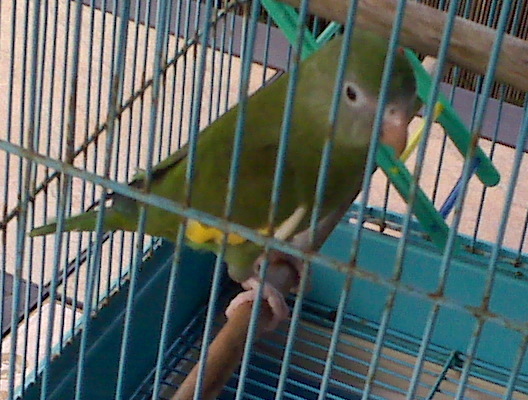 What type of parrot is this?
Question
Friendly bird
A week ago ths small parrot flew
What type of parrot is this?
Question
Friendly bird
A week ago ths small parrot flew
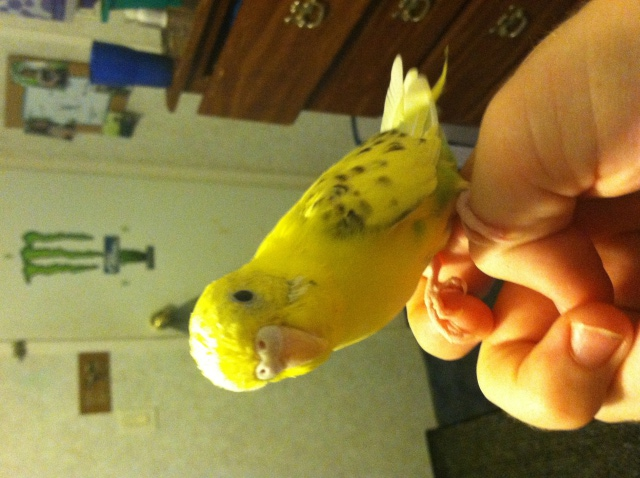 Parakeet gender
Question
Parakeet
Hi, I looked for an expert und
Parakeet gender
Question
Parakeet
Hi, I looked for an expert und
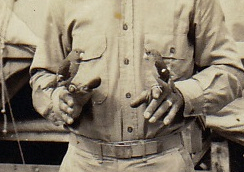 ID Birds
Question
Panama Birds
My uncle served in Panama in 1941
ID Birds
Question
Panama Birds
My uncle served in Panama in 1941
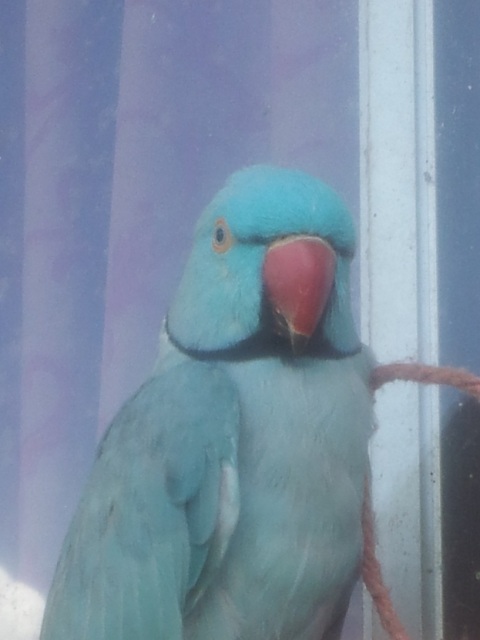 RE: Indian Ringneck probems
Question
Indy our Ringneck
Thank you for your he
RE: Indian Ringneck probems
Question
Indy our Ringneck
Thank you for your he
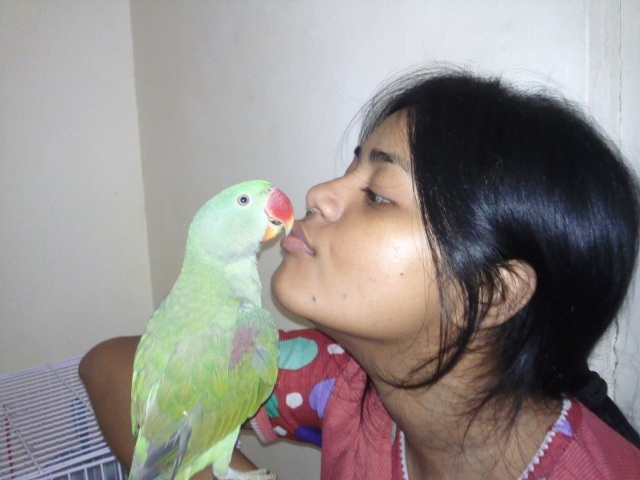 can i give my parrot chole(chana) called in hindi
Question
my little chaddi alexa
dear sir,
can give chan
can i give my parrot chole(chana) called in hindi
Question
my little chaddi alexa
dear sir,
can give chan